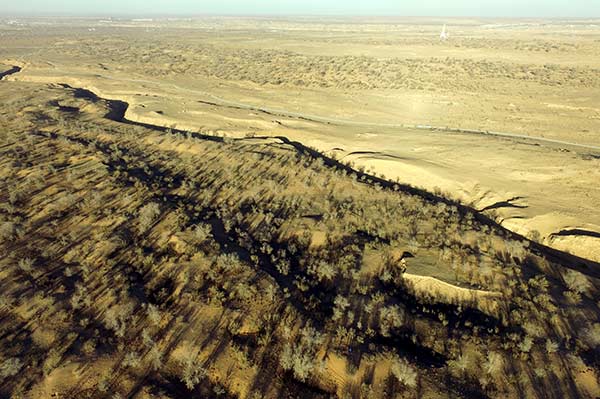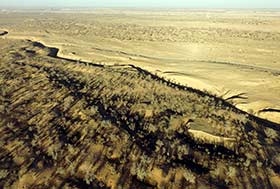Saving China from 'cancer of the Earth'
 |
|
A bird's-eye view of Babusha, a large sand dune on the southern edge of the Tengger desert in Northwest China. [Photo/China Daily] |
The government is promoting measures to eradicate desertification, one of the most-pressing problems facing China's western regions, and looking to reclaim vast areas of land. Su Zhou reports from Beijing with Xue Chaohua in Lanzhou.
In January, 65-year-old Guo Wangang took over his father's job. His work is of national importance, but he isn't running a giant corporation; instead he is guarding the Babusha Forest Farm in Gulang, a county in the northwestern province of Gansu.
In the 1970s, Babusha, an enormous sand dune on the southern edge of the Tengger desert, gradually encroached south, threatening the county's social and economic development and the livelihoods of the people who lived there.
"Rather than bow down to the desert's advance and become ecological refugees, six local farmers, including my father, Guo Chaoming, decided to plant trees to improve soil absorption and prevent the spread of the desert by fixing the sand in place," said Guo Wangang, who is head of the farm. "They did it all voluntarily, despite the fact that they could not even feed themselves at the time."
After three decades, the combined efforts of two generations have paid off. The desertification of the 75,000-square-meter area has been reversed and Gulang has once again become a vibrant forest farm, where produce is grown and sheltered under a canopy of greenery. The dramatic change has prompted more than 30,000 people from the surrounding areas to settle in the once-threatened county.
Shrinking deserts
The Guo family's story is a microcosm of China's lengthy battle against desertification, often described as "cancer of the Earth". It is the most serious ecological issue facing China, especially in western areas such as Gansu and the Ningxia Hui, Inner Mongolia and Xinjiang Uygur autonomous regions.
According to the latest survey by the State Forestry Administration, the areas affected by desertification and sandification - where the top soil has been stripped away and replaced by sand - are shrinking.
By the end of 2014, the area of desertified land nationwide had fallen by 12,120 square kilometers to 2.6 million sq km, and the area of sandified land had retreated by 9,902 sq km to 1.7 million sq km.
China has vowed to step up efforts to tackle desertification and land degradation and the government plans to reclaim 100,000 square kilometers of sandified land by 2020.
In recent decades, the country has gained rich experience of combating desertification and is now an international leader in the field.
Shapotou, a district of Zhongwei, a prefecture-level city in Ningxia, first hit the headlines not because of tourism, but as a result of successful innovations in desertification control, said Wang Fuzhong, chairman of the Ningxia Shapotou Tourism Industry Group.
He recalled that many tourists from overseas were eager to visit Shapotou in the 1970s and 80s because it was the birthplace of the now globally renowned "straw checkerboard" technique, in which straw, usually made from wheat or rice stalks, is laid out like a grid across the sand and then partially buried.
























